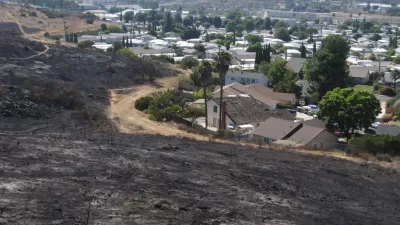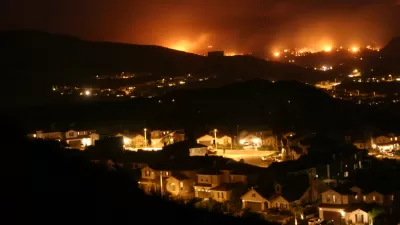Fuel breaks involve clearing vegetation that feeds fires in order to prevent the catastrophic and fast-spreading wildfires that have plagued the state.

After last year’s devastating fires in California, communities throughout the state are looking to put in fuel breaks as a strategy against wildfire threats, report Katie Brown and Lisa M. Krieger:
The fuel breaks vary widely in size and shape. In forests, you may not even notice them: The trees’ leafy canopies are left intact, but the forest floor is cleaned up. In open areas, they resemble swaths of low vegetation. Along the sides of paved roads, 20 to 30 feet of vegetation is cleared.
Fuel breaks protect homes and buildings by stopping or slowing the spread of flames. But they also help firefighters access sites where fires are burning and can provide safe areas while they are battling blazes.
They have proven to be an effective way to reduce fire risks in areas where vegetation has built up. At $2,000 to $3,000 an acre, however, they are costly to build and require maintenance and substantial administrative legwork. Still, fighting fires is much more costly than prevention, say community advocates.
Governor Gavin Newsom has included $213.6 million in the state budget for programs to clear and reduce vegetation in vulnerable, fire-prone areas. "Newsom also wants to spend $4.5 million to create a new California Conservation Corps program devoted exclusively to making wild landscapes safer," note Brown and Krieger.
FULL STORY: Destruction of Paradise fire spurs rush to build fuel breaks

Planetizen Federal Action Tracker
A weekly monitor of how Trump’s orders and actions are impacting planners and planning in America.

Congressman Proposes Bill to Rename DC Metro “Trump Train”
The Make Autorail Great Again Act would withhold federal funding to the system until the Washington Metropolitan Area Transit Authority (WMATA), rebrands as the Washington Metropolitan Authority for Greater Access (WMAGA).

The Simple Legislative Tool Transforming Vacant Downtowns
In California, Michigan and Georgia, an easy win is bringing dollars — and delight — back to city centers.

The States Losing Rural Delivery Rooms at an Alarming Pace
In some states, as few as 9% of rural hospitals still deliver babies. As a result, rising pre-term births, no adequate pre-term care and "harrowing" close calls are a growing reality.

The Small South Asian Republic Going all in on EVs
Thanks to one simple policy change less than five years ago, 65% of new cars in this Himalayan country are now electric.

DC Backpedals on Bike Lane Protection, Swaps Barriers for Paint
Citing aesthetic concerns, the city is removing the concrete barriers and flexposts that once separated Arizona Avenue cyclists from motor vehicles.
Urban Design for Planners 1: Software Tools
This six-course series explores essential urban design concepts using open source software and equips planners with the tools they need to participate fully in the urban design process.
Planning for Universal Design
Learn the tools for implementing Universal Design in planning regulations.
Smith Gee Studio
City of Charlotte
City of Camden Redevelopment Agency
City of Astoria
Transportation Research & Education Center (TREC) at Portland State University
US High Speed Rail Association
City of Camden Redevelopment Agency
Municipality of Princeton (NJ)




























